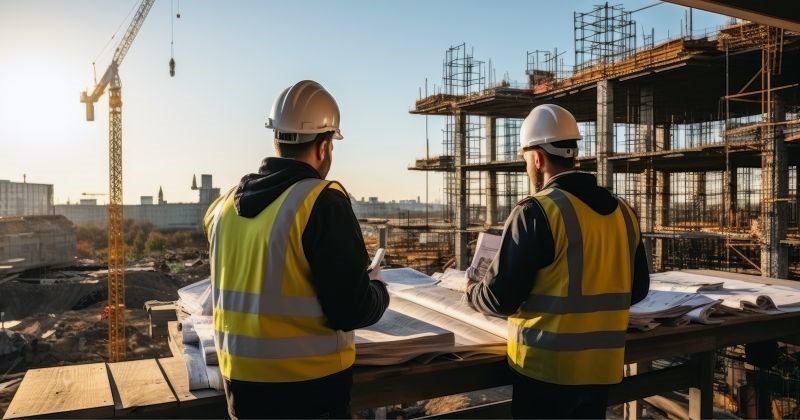by Jeffrey C Kadlowec, Architect
Abstract
The profitability of a construction company is greatly affected by the productivity of its labor. Substantial savings in production time and project cost can be facilitated through proper management of resources. Identifying and analyzing a variety of factors is crucial in recognizing areas of improvements. New techniques should be implemented to achieve better performance. Rethinking and refining managerial strategies and practices will ultimately lead to gains in productivity and performance.
Keywords: building construction, labor productivity, performance improvement, managerial practices

Productivity and Performance
The success of any construction project is dependent on a wide variety of performance indicators. These greatly affect the labor profitability of a construction company, making them commonly discussed and well-debated topics [Hatzigeorgiou 2017]. Manufacturing industries are highly standardized and extremely automated under controlled conditions, so comparisons to this sector are not accurate or entirely relevant. The changing site conditions, variety of building trades, and numerous stakeholders with conflicting interests create an environment where strategic management becomes critical.
Productivity has been important for competitiveness and prosperity since the beginning of industrialization [Pekuri 2011]. It can be a significant source of advantage for companies, while contributing to the well-being of society. Due to the size of the industry, construction is an important and influential variable affecting the economy.
Low productivity yields are often the result of inefficient management of construction resources [Shehata 2011]. Contractors and construction managers must be aware of methods for evaluating productivity of equipment and labor. Maintaining control of these contributing factors can achieve the expected income levels.


Productivity improvement however is not simply a matter of completing as many task possible in the shortest time allowable. The key is focusing on a predictable work flow to match current workload with available capacity [Shehata 2011].
Automatic identification systems were developed to acquire data from equipment sensors [Kasai 2023]. These include detection of motion, repetition and walking, along with estimation of posture, location and travel distance. This empirical data can then be charted and analyzed in order to determine productivity gaps and develop methods for optimization. Constant monitoring of this data provides notification of maximum rates, sustainable output levels and potential slowdowns.
Many construction projects are plagued by low labor productivity resulting in increased timelines and production costs. Given the rate of growth in large city centers and the ongoing labor shortages, project managers often dictate mandatory overtime. Unfortunately, studies like [Badawi 2023] show that this commonly leads to further decreased in productivity and obvious wage increases. These findings indicate that each worker on average experiences a 10% decrease in efficiency for every extra 10 hours per week of overtime. There is a cumulative effect to this decrease, regardless of pay rates, dropping to roughly 25% in the second month.
In a formal study by [Bamfo-Agyei 2022], the goal was to determine the optimal productivity of construction workers on labor-intensive projects. The objectives were to identify influential factors, determine techniques for improvement, and develop a framework for improving productivity. Utilizing a quantitative research method and implementing a questionnaire, it was determined that the leading factors were: 1) incentive for good performance, 2) opportunities to exercise skills, 3) likelihood of on-time payment, 4) management response to grievances, 5) knowledge of scientific techniques, 6) attitude towards the job, 7) knowledge of career prospects, and 8) promotion opportunities. Focusing on providing or improving some these items will have a positive impact on job-site productivity and performance.
References
Badawi Saluy, Ahmad; Djamil, Masydzulhak; Madelan, Sugiyono; Primawanto, Sonny; Pangkey, Dicky; Kemalasari, Novawiguna & Mz, Masydzulhak. (2023). Analysis of Labor Overtime and Productivity in Construction Projects. 17. 559. 10.5281/zenodo.7073499.
Bamfo-Agyei, Emmanuel; Thwala, Wellington & Aigbavboa, Clinton. (2022). Performance Improvement of Construction Workers to Achieve Better Productivity for Labour-Intensive Works. Buildings. 12. 1593. 10.3390/buildings12101593.
Hatzigeorgiou, Alexandros & Manoliadis, Ody. (2017). Improving Performance of Building Construction Projects: A New Approach of Labor Productivity Benchmarks.
Kasai, Ryuji; Goso, Takashi & Osawa, Tetsuro. (2023). Development of a program for automatic identification of productivity of construction workers. IOP Conference Series: Earth and Environmental Science. 1195. 012042. 10.1088/1755-1315/1195/1/012042.
Pekuri, Aki; Haapasalo, Harri & Herrala, Maila. (2011). Productivity and performance management – Managerial practices in the construction industry. International Journal of Performance Measurement. 1. 39-58.
Shehata, Mostafa & El-Gohary, Khaled. (2011). Towards improving construction labor productivity and projects’ performance. Alexandria Engineering Journal. 50. 321-330. 10.1016/j.aej.2012.02.001.



